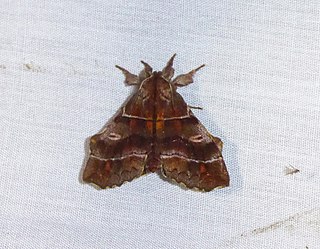
Apatelodidae, the American silkworm moths, is a family of insects in the order Lepidoptera. They are a family within the superfamily Bombycoidea, though they have in the past been considered a subfamily of Bombycidae.
Falcatelodes is a monotypic genus of moths of the family Apatelodidae. It was erected by Max Wilhelm Karl Draudt in 1929, and contains a single species, Falcatelodes anava, which was first described by Herbert Druce in 1890.
Thelosia is a genus of moths of the Apatelodidae family. It was first described in 1896 by William Schaus, containing at the time three species: Thelosia phalaena, T. camina and T. truvena. Since then, several additional species have been described.

Zanola is a genus of moths in the family Apatelodidae.
Ephoria eadgara is a moth in the Apatelodidae family. It was described by Schaus in 1934. It is found in Brazil.
Ephoria marginalis is a moth in the family Apatelodidae. It was described by Francis Walker in 1856. It is found in Brazil.
Drepatelodes tanais is a moth in the family Apatelodidae. It was described by Herbert Druce in 1898. It is found in Costa Rica.
Apatelodes vistana is a moth in the family Apatelodidae. It is found in Colombia.
Zanola impedita is a moth in the family Apatelodidae. It was described by Paul Dognin in 1916. It is found in Colombia.
Thelosia camina is a moth in the Apatelodidae family. It was described by William Schaus in 1896. It is found in Brazil (Parana).
Thelosia jorgenseni is a moth in the Apatelodidae family. It was described by William Schaus in 1927. It is found in Paraguay.
Thelosia mayaca is a moth in the Apatelodidae family. It was described by William Schaus in 1939. It is found in Peru.
Thelosia meldola is a moth in the Apatelodidae family. It was described by William Schaus in 1900. It is found in Brazil (Parana).
Thelosia minois is a moth in the Apatelodidae family. It was described by William Schaus in 1892. It is found in Brazil.
Thelosia phalaena is a moth in the Apatelodidae family. It was described by William Schaus in 1896. It is found in Brazil.
Thelosia truncata is a moth in the Apatelodidae family. It was first described by William Schaus in 1894, as Trabala (?) truncata. It is found in Brazil (Parana).
Thelosia postflavida is a moth in the family Apatelodidae. It was described by Max Wilhelm Karl Draudt in 1929, with a type locality in Brazil.
Thelosia resputa is a moth species in the family Apatelodidae. It was first described by Max Wilhelm Karl Draudt in 1929 based on a female specimen from the collection of Otto Staudinger held by the Natural History Museum, Berlin. The location where the type specimen was collected is unknown, and the species therefore has no type locality.
Olceclostera ibar is a moth in the Apatelodidae family. It is found in Argentina.
Morpheis impedita is a moth in the family Cossidae. It was described by Wallengren in 1860. It is found in South America.

